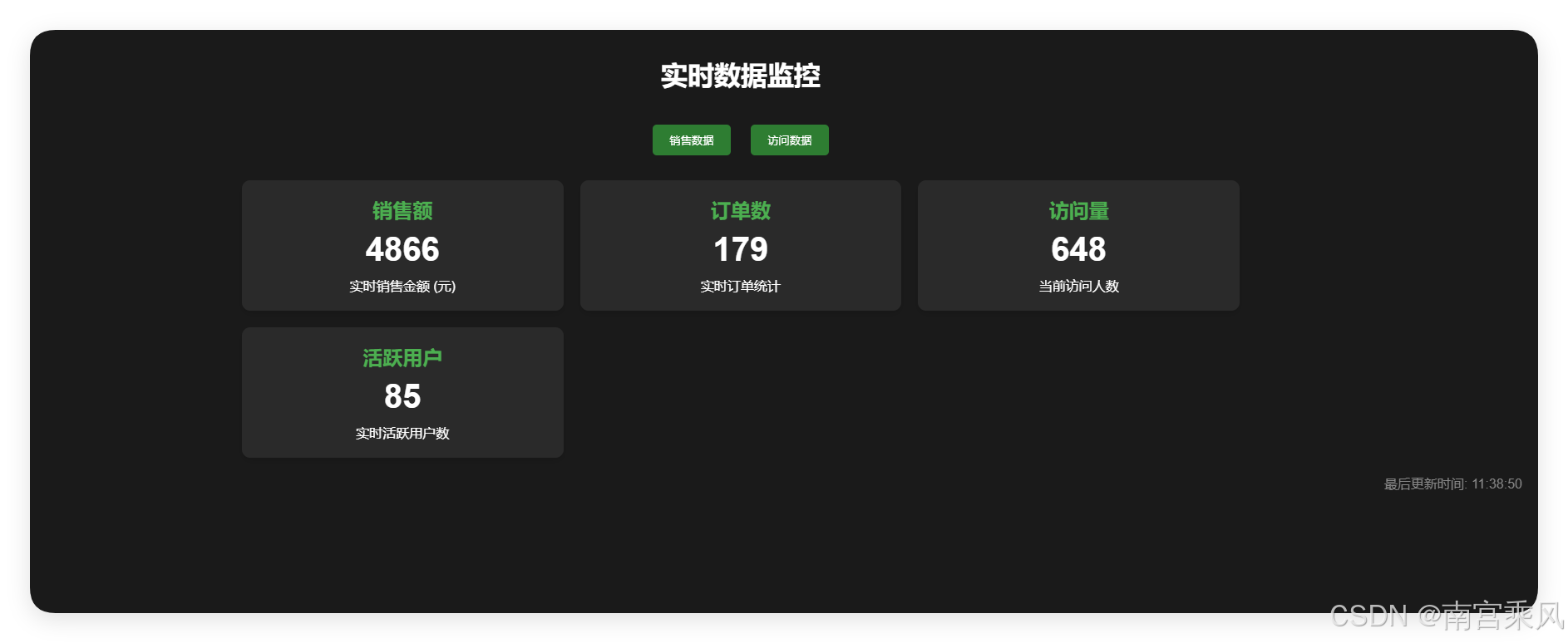简介
请参考下方,学习入门操作
基于 Flask 和 Socket.IO 的 WebSocket 实时数据更新实现
在当今数字化时代,实时性是衡量互联网应用的重要指标之一。无论是股票交易、在线游戏,还是实时监控大屏,WebSocket 已成为实现高效、双向实时通信的最佳选择之一。本文将通过一个基于 WebSocket 实现的实时数据大屏案例,深入探讨 WebSocket 的高级用法和优化技巧。
WebSocket 的典型应用场景
- 实时数据监控:如运营监控大屏、设备状态监控等。
- 在线协作:如 Google Docs 的多人编辑。
- 实时聊天:如即时通讯工具。
- 实时通知:如电商的价格变动提醒。
场景分析:实时数据监控大屏
本案例的目标是实现一个实时数据监控大屏,通过 WebSocket 技术,将实时更新的数据动态展示在用户界面中。
需求分析
- 实现不同房间的数据订阅(如销售数据和访问数据)。
- 支持多客户端实时接收服务器推送的最新数据。
- 动态更新界面,提供流畅的用户体验。
技术选型
- 前端:HTML、CSS、JavaScript 使用 Socket.IO 客户端库。
- 后端:基于 Flask 和 Flask-SocketIO 实现 WebSocket 服务。
- 实时数据生成:使用 Python 的
random模块模拟实时数据。
后端实现
|
|
数据生成与推送
后端的核心逻辑是数据生成与推送:
- 数据生成:通过
generate_sales_data和generate_visitor_data函数生成随机数据,并定时推送到客户端。 - 房间管理:通过
join_room和leave_room方法管理客户端的房间订阅。 - 线程管理:使用线程来生成数据,并在客户端离开房间时停止线程。
HTML 结构
|
|
JavaScript 逻辑
在前端代码中,我们使用了 Socket.IO 客户端库来与服务器进行 WebSocket 通信。主要逻辑如下:
- 连接服务器:通过
io()方法连接到服务器。 - 切换房间:用户点击按钮时,通过
toggleRoom函数切换不同的数据房间。 - 更新数据:监听
update_data事件,更新页面上的数据。




WebSocket 的高级实践与优化
在实际应用中,可能需要管理多个房间,每个房间对应不同的数据类型或用户组。通过 join_room 和 leave_room 方法,可以轻松实现多房间管理。
数据压缩与优化
对于大规模数据传输,可以考虑使用数据压缩技术来减少带宽占用。例如,使用 gzip 或 brotli 压缩数据包,或者在前端进行数据解压缩。
断线重连与心跳机制
WebSocket 连接可能会因为网络问题而断开。为了保证连接的稳定性,可以实现断线重连机制和心跳包检测。通过定时发送心跳包,可以及时检测连接状态,并在断线时自动重连。
安全性与权限控制
在生产环境中,安全性是一个不可忽视的问题。可以通过以下方式增强 WebSocket 连接的安全性:
- 使用 HTTPS:确保 WebSocket 连接通过加密的 HTTPS 协议进行。
- 身份验证:在连接建立时进行身份验证,确保只有授权用户才能访问数据。
- 权限控制:根据用户角色控制其访问的房间和数据类型。
扩展与定制
WebSocket 的应用场景非常广泛,可以根据具体需求进行扩展和定制。例如,结合 WebRTC 实现实时音视频通信,或者结合 WebGL 实现实时3D数据可视化。
